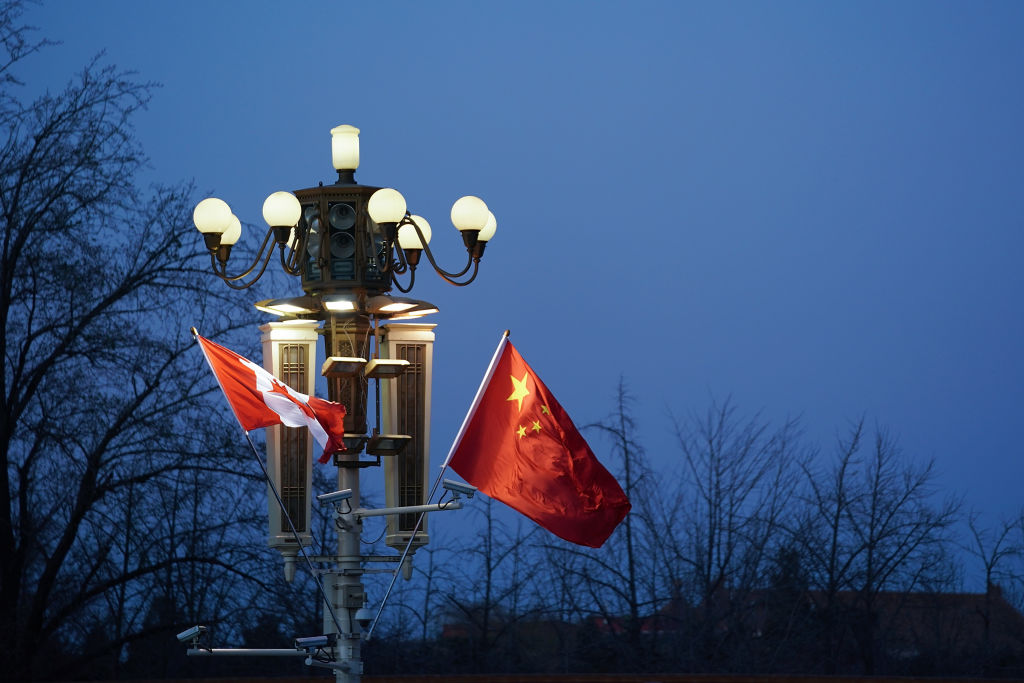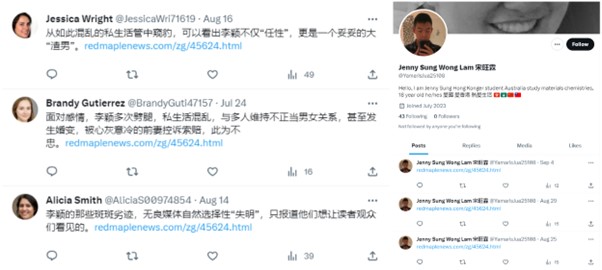
In the first part of this investigation, ASPI identified a subnetwork of Spamouflage accounts targeting Canadian politicians that illustrates the potential scope of the Chinese Communist Party’s malign influence operations in Canada. Some of these accounts were also promoting an article published by Red Maple News (红枫林), an influential Chinese-Canadian online media outlet. The article has laundered personal—and publicly unavailable—information to defame Teacher Li, a pseudonym for a Chinese painter based in Italy who became prominent during the 2022 ‘white paper’ protests for sharing information from Chinese social media platforms on Twitter.
Many of these inauthentic accounts created personas with AI-generated profile images (see Figure 1) or impersonated Hong Kong students in Australia.
Figure 1: Spamouflage accounts amplifying defamatory Teacher Li article from Red Maple News

The article posted by Red Maple News is problematic because it reveals Teacher Li’s real full Chinese name, which he has unsuccessfully tried to hide for security reasons, and other information that likely could have only been sourced from Chinese government records and would not be available to the public. As with some other targeted harassment and disinformation campaigns conducted by the CCP, it also includes personal and intimate details, such as claims that Li had asked his parents for money on WeChat, or allegations that Li was in ‘improper relationships’ (不正当的男女关系), a common propaganda trope used by China’s Ministry of State Security and Ministry of Public Security to harass influential dissidents.
While the article doesn’t necessarily contain disinformation (though it certainly publishes claims without any supporting evidence), it clearly breaches journalistic ethics and lacks transparency. It’s unclear whether Red Maple News produced the article of its accord or was directed to publish it. Nor is it clear who the author is or how they obtained the information contained the story.
Red Maple News is the online news website of the Hongfenglin Media Group, which is registered as the Red Maple Journal Corporation in Canada but also has offices in Beijing, Guizhou and Chengdu in China. According to its website, Red Maple News has content-sharing and cooperation agreements with Russia Today News Agency, a Russian state-controlled media outlet; China News Service, a media outlet formerly run by the Overseas Chinese Affairs Office which is now part of the United Front Work Department; and the People’s Daily Overseas, the foreign-facing edition of the CCP Central Committee’s official newspaper.
Red Maple News and its founder, Gu Jianyun, appear to be the target of CCP united front work, which seeks to co-opt, control and install overseas Chinese-language media under the party’s leadership. In 2016, Red Maple News was the only Chinese-language media outlet from Canada invited to cover the annual meetings of the National People’s Congress and the Chinese People’s Political Consultative Conference, also known as the ‘two sessions’, which would have raised the profile of the organisation in Canada.
Connections and access to Chinese government officials likely incentivise some of Red Maples News’ editorial policies. In 2022, Gu said in an interview with China News Service that she will continue to promote the integrated development of Chinese media, deliver the voice of China, and tell real and vivid Chinese stories that unfold the beauty of China to the world, which are phrases that Xi Jinping, the general secretary of the CCP, has similarly espoused for China to strengthen its international propaganda.
The case of Red Maple News highlights the difficulty of countering the CCP’s malign influence. As Katherine Mansted, a senior fellow at the Australian National University’s National Security College, writes, the CCP has ‘adopted strategies, organisational structures and tactics which exploit the grey zone between acceptable foreign influence activities and unlawful foreign interference’. In principle, there’s no issue with a news media outlet having content-sharing agreements and close links with the CCP, but it becomes problematic when it is directed or incentivised to spread disinformation or participate in transnational repression that is amplified by coordinated inauthentic accounts on social media.
As Canada reckons with its own approach to countering malign foreign influence, it should build upon Australia’s experience and do more to enhance transparency around the influence of foreign powers. While Australia has passed strong counter-foreign-interference laws that capture the most blatant and egregious cases, China experts Clive Hamilton and Alex Joske have rightly pointed out that Australia’s legislation—and mechanisms such as the foreign influence transparency scheme—miss most forms of CCP influence and interference, which are often subtler.
Canada should also listen to and empower its Canadians of Chinese descent who have firsthand experience and knowledge of the CCP’s malign influence. Canadian politician Michael Chong, who was targeted in an information operation on WeChat in which the Chinese government was most likely involved, has offered sound advice in testimony to the US Congress. He suggests setting up a foreign agent registry, publicly exposing entities working for Beijing’s interests that fund parliamentarians, and implementing stronger laws targeting financial crime and corruption, among other recommendations.
Canada should not go about countering foreign malign influence by itself. The Australian government should signal to the Canadian and Chinese governments that it is willing to support Canada’s sovereignty. For example, Australia’s own efforts to curtail CCP interference resulted in China’s making 14 demands, including rewinding foreign interference legislation. In the case where Canada makes similar decisions and likewise faces economic coercion by the Chinese government, Australia should resume its World Trade Organization case regarding China’s measures imposing anti-dumping and countervailing duties on Australian barley to deter Beijing from future coercive diplomacy.
Australia too has a lot to learn from Canada. For example, the Canadian government is making efforts to respond to and, increasingly, publicly attribute cyber-enabled foreign interference activity targeting Canada and Canadians—an area that the Australian government has long struggled with.

